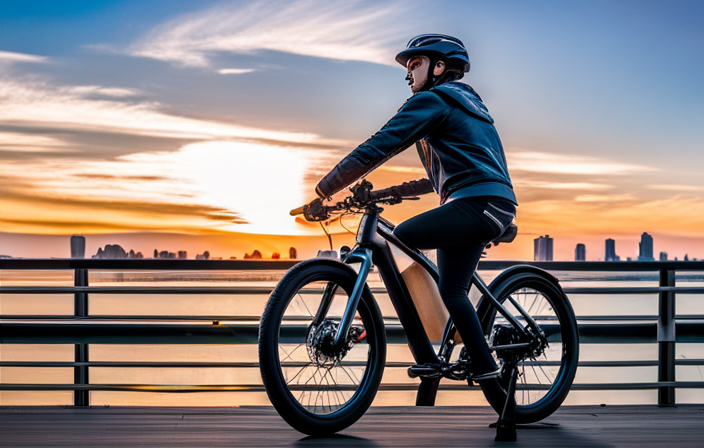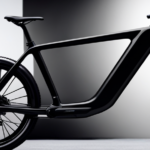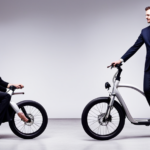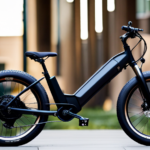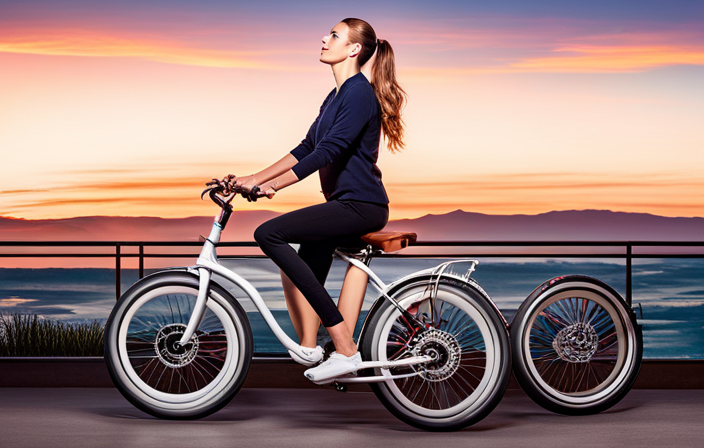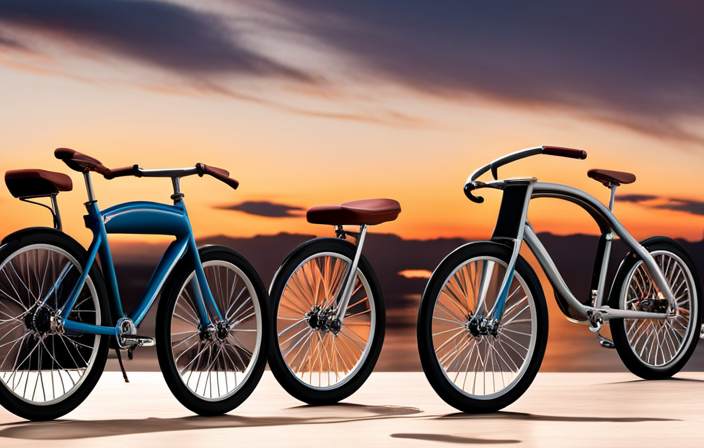As a passionate cyclist, I’ve always been intrigued by the concept of electric bikes. The juxtaposition of traditional cycling with modern technology creates a captivating rhythm that I can’t resist.
So, just how big are these electric marvels? In this article, we’ll delve into the different types of electric bikes, explore frame sizes and geometry, consider wheel sizes and weight, and even touch on battery placement and overall dimensions.
Get ready to be amazed by the sheer versatility and size options of electric bikes!
Key Takeaways
- Electric bikes come in different frame sizes, including small, medium, and large, to cater to riders of different heights and provide a comfortable riding experience.
- The size of electric bike wheels can range from 20 inches to 29 inches, with each size offering different advantages such as nimble handling, stability, and suitability for off-road adventures.
- Battery placement in electric bikes varies, affecting weight distribution and handling. Consider overall dimensions for storage and transportation, with compact options available for urban commuting.
- Folding electric bikes offer the benefit of portability and easy storage. They have compact dimensions when folded, making them suitable for commuters or those with limited storage space.
Types of Electric Bikes
There are several different types of electric bikes available for you to choose from. When it comes to frame materials, you have options such as aluminum, steel, carbon fiber, and titanium.
Aluminum frames are lightweight, durable, and affordable, making them a popular choice among riders. Steel frames, on the other hand, offer a smooth and comfortable ride due to their natural flexibility. Carbon fiber frames are incredibly lightweight and provide excellent vibration damping, making them ideal for those seeking a high-performance electric bike. Titanium frames are known for their strength, durability, and corrosion resistance, but they come with a higher price tag.
Moving on to motor types, electric bikes typically come with either hub motors or mid-drive motors. Hub motors are located in the front or rear wheel and provide direct power to drive the bike forward. They are quiet, low maintenance, and offer a smooth riding experience. Mid-drive motors, on the other hand, are positioned near the bike’s bottom bracket, providing a more balanced weight distribution and better handling. They also offer higher torque, making them suitable for hilly terrains or off-road riding.
Now, let’s transition to the subsequent section about frame sizes and geometry.
Frame Sizes and Geometry
When it comes to frame sizes and geometry in electric bikes, there are three key categories: small, medium, and large.
Small frame sizes are designed for riders who are on the shorter side, typically under 5’5′. These bikes offer a more compact and nimble ride, perfect for maneuvering through tight spaces.
Medium frame sizes are ideal for riders between 5’5′ and 5’9′, offering a balanced combination of agility and comfort.
Small Frame Sizes
Electric bikes come in small frame sizes, making them suitable for riders of all heights. These compact frames are designed to provide a comfortable and efficient riding experience.
Here are some key details about small frame sizes:
-
Frame material: Small electric bikes often feature lightweight materials like aluminum or carbon fiber. This ensures that the bike remains agile and easy to maneuver, even with a smaller frame size.
-
Suspension options: Despite their smaller size, many electric bikes with small frames still offer suspension options. This can include front suspension forks or even full suspension systems. These features help absorb shocks and provide a smoother ride, especially on rough terrain.
-
Compact and versatile: Small electric bikes are perfect for urban commuting or exploring tight trails. Their compact size makes them easy to store and transport, while still offering the power and performance of larger electric bikes.
Transitioning to the next section about medium frame sizes, it’s worth noting that these frames offer a balance between the compactness of small frames and the stability of larger ones.
Medium Frame Sizes
Medium frame sizes provide a balance between compactness and stability, offering riders a versatile and comfortable riding experience. When choosing a medium frame size for your electric bike, it’s important to consider both the frame material options and the frame size chart.
The frame material options typically include aluminum and carbon fiber. Aluminum frames are lightweight and durable, while carbon fiber frames are even lighter and offer better shock absorption.
To determine the right frame size for you, refer to the frame size chart provided by the manufacturer. This chart will usually take into account your height and inseam length to suggest the appropriate frame size.
As we move on to discussing large frame sizes, it’s important to consider the advantages they offer in terms of stability and control.
Large Frame Sizes
To find the right fit for you, consider the advantages of opting for a larger frame size in terms of stability and control.
When it comes to electric bikes, frame size plays a crucial role in ensuring a comfortable and enjoyable riding experience. Larger frame sizes provide more stability, especially at higher speeds or on rough terrains. They also offer better control, allowing you to maneuver the bike with ease.
When choosing a larger frame size, make sure to consider the frame material as well. Different materials, such as aluminum or carbon fiber, can affect the weight and durability of the bike.
Additionally, frame sizing tips, like measuring your inseam and consulting size charts, can help you find the perfect fit.
Speaking of fit, another important factor to consider is wheel size.
Wheel Sizes
When it comes to electric bike wheel sizes, there are three key options to consider: 20-inch, 26-inch, and 29-inch wheels. Each size has its own advantages and disadvantages, and choosing the right one for your needs is crucial.
20-inch wheels offer nimble handling and are great for maneuvering through tight spaces, while 26-inch wheels provide a good balance of agility and stability.
On the other hand, 29-inch wheels are known for their superior rolling ability and ability to tackle rough terrain with ease.
20-inch Wheels
You’ll be happy to know that electric bikes with 26-inch wheels are available for a smooth and comfortable ride. When it comes to electric bikes, the size of the wheels plays a crucial role in determining the overall performance and riding experience.
One of the advantages of larger wheels, like the 26-inch ones, is their ability to roll over obstacles more easily. This is particularly beneficial when riding on uneven terrain or encountering bumps along the way. Additionally, larger wheels provide better stability and control, especially at higher speeds.
When choosing the right tire size for your electric bike, it’s important to consider your riding style, the type of terrain you’ll be riding on, and your personal preferences. Now let’s dive into the details of 26-inch wheels and explore their features and benefits.
26-inch Wheels
Moving on from discussing inch wheels, let’s delve deeper into the topic of wheel diameter and its impact on electric bikes.
When it comes to wheel size, there are various options available, each with its own set of advantages and considerations. The wheel diameter directly affects the ride quality and performance of the electric bike.
Smaller wheels, such as 20 inches, offer increased maneuverability and agility, making them ideal for urban environments. On the other hand, larger wheels, like 29 inches, provide better stability and a smoother ride, making them suitable for off-road adventures.
Additionally, the wheel diameter also influences the tire options available. Smaller wheels tend to have a wider range of tire choices, while larger wheels often have more specialized options for specific terrains.
Now, let’s explore the fascinating world of inch wheels and the unique advantages they offer.
29-inch Wheels
To fully understand the advantages of inch wheels, let’s explore their impact on ride quality and performance.
The wheel diameter plays a crucial role in determining the overall feel and handling of a bike. With larger wheels, such as 29 inches, you can expect a smoother ride over rough terrain, as the larger diameter helps absorb bumps and obstacles more effectively. Additionally, larger wheels offer better traction and stability, especially when cornering at high speeds.
When it comes to tire options, inch wheels provide a wider range of choices. Whether you prefer wider tires for increased grip or narrower ones for reduced rolling resistance, you’ll find plenty of options to suit your riding style and terrain.
Now, let’s delve into weight considerations and how they impact electric bike performance.
Weight Considerations
If you’re looking for an electric bike, one thing to consider is the weight. The weight of an electric bike can have a significant impact on your riding experience and overall enjoyment. Here are a few key points to keep in mind when it comes to weight considerations:
-
Battery Range:
One factor that contributes to the weight of an electric bike is the size of the battery. Larger batteries generally offer a longer battery range, allowing you to ride for extended periods without worrying about running out of power. However, it’s important to note that larger batteries can also add more weight to the bike. So, if you prioritize a longer battery range, you may need to accept a slightly heavier bike. -
Motor Power:
Another factor that affects the weight of an electric bike is the motor power. More powerful motors tend to be larger and heavier, as they require additional components to generate the extra power. On the other hand, if you opt for a bike with a less powerful motor, it can contribute to a lighter overall weight.
Considering the weight of an electric bike is crucial to finding the right balance between battery range and motor power. Now, let’s delve into the next section, which focuses on battery placement and size.
Battery Placement and Size
When considering battery placement and size, it’s important to find a balance that suits your needs and preferences. The battery size plays a crucial role in determining the range and overall performance of an electric bike. A larger battery will typically provide a longer battery life, allowing you to ride for extended periods without worrying about running out of power. However, it’s essential to consider the weight and size of the battery, as it can affect the bike’s maneuverability and overall comfort.
To help you understand the different battery sizes and their corresponding benefits, take a look at the table below:
| Battery Size | Battery Life | Weight | Compactness |
|---|---|---|---|
| Small | Short | Light | High |
| Medium | Moderate | Average | Moderate |
| Large | Long | Heavy | Low |
As you can see, choosing a battery size depends on your priorities. If you prioritize portability and compactness, a small battery may be suitable. However, if you value longer rides without frequent recharging, a larger battery would be a better choice, even though it may add some weight to the bike.
Now that we’ve explored battery placement and size, let’s move on to discussing motor placement and power, which are equally important components for optimizing an electric bike’s performance.
Motor Placement and Power
Choosing the right motor placement and power is crucial for optimizing an e-bike’s performance. The motor is the heart of an electric bike, providing the necessary power to propel you forward. Here are some key considerations when it comes to motor placement and power:
-
Motor efficiency: Look for a motor that is highly efficient, as this will ensure maximum power output while minimizing energy wastage. An efficient motor will help improve the overall battery range of your e-bike.
-
Motor placement: There are various options for motor placement, including hub motors and mid-drive motors. Hub motors are located in the front or rear wheel hub, while mid-drive motors are positioned near the bike’s bottom bracket. Each placement has its advantages and disadvantages, so choose one that suits your riding style and terrain.
-
Power rating: The power rating of the motor is measured in watts and determines how much assistance you’ll get while riding. Higher power ratings provide more torque and acceleration, making them suitable for hilly terrains or off-road adventures.
-
Torque sensor: Consider opting for a motor with a torque sensor, as it provides a more natural and responsive riding experience. A torque sensor measures the force you apply to the pedals and adjusts the motor assistance accordingly.
-
Motor control: Look for e-bikes with adjustable motor settings, allowing you to fine-tune the level of assistance you receive. This gives you more control over the motor’s power output, helping to maximize battery range.
Choosing the right motor placement and power is essential for optimizing your e-bike’s performance and maximizing your battery range. Now, let’s delve into the next section about handlebar and stem options, which play a crucial role in comfort and control while riding an electric bike.
Handlebar and Stem Options
When it comes to choosing handlebars for your electric bike, there are a few options to consider.
One popular choice is flat handlebars, which provide a more relaxed and upright riding position.
Another option is riser handlebars, which offer a more aggressive and aerodynamic riding position.
Additionally, adjustable stems are available to customize the reach and height of your handlebars, allowing for a personalized fit and optimal comfort on your electric bike.
Flat Handlebars
If you want a more comfortable riding position, consider opting for flat handlebars on your electric bike.
Flat handlebars, also known as straight handlebars, are a popular choice for electric bike riders looking for a more relaxed and upright riding position.
Unlike drop handlebars commonly found on road bikes, flat handlebars provide a wider grip and allow for a more natural and comfortable hand position.
This can help reduce strain on your wrists, shoulders, and neck during long rides.
To further customize your riding position, you can also consider adjustable stems.
These allow you to change the angle and height of your handlebars, providing even more comfort and flexibility.
Now, let’s move on to another handlebar option: riser handlebars.
Riser Handlebars
For a more upright riding position, consider opting for riser handlebars on your e-bike. Riser handlebars are designed with an ergonomic design that allows you to sit more comfortably and reduces strain on your back and shoulders.
These handlebars have a slight upward curve at the ends, which raises your hands higher and closer to your body. This position promotes a more natural and relaxed posture while riding, making it ideal for longer rides or those with back issues.
Additionally, the raised position of the handlebars gives you better control and maneuverability, especially when navigating through tight spaces or rough terrains.
Now, let’s move on to adjustable stems, which offer even more flexibility in finding the perfect riding position.
Adjustable Stems
Moving on from discussing riser handlebars, let’s now delve into the world of adjustable stems.
Adjustable stems are a great feature to have on an electric bike as they offer several benefits. Firstly, they allow riders to easily adjust the height and reach of their handlebars, providing a customizable fit for maximum comfort and control. This is especially useful for riders with different body proportions or those who prefer to switch between different riding styles.
Moreover, adjustable stems can also accommodate riders who may have limited flexibility or mobility, allowing them to find a position that suits their needs.
When comparing adjustable stems to fixed stems, the main advantage lies in their versatility. Fixed stems are set at a specific angle and cannot be adjusted, limiting the rider’s ability to fine-tune their riding position. On the other hand, adjustable stems offer a wider range of adjustability, allowing riders to find the perfect balance between comfort and performance.
Now, let’s transition into discussing seat and seatpost options without skipping a beat.
Seat and Seatpost Options
When it comes to choosing the right seat for your electric bike, there are a few key options to consider.
Comfort-oriented seats provide extra padding and support for a more relaxed riding experience, while performance-oriented seats are designed for maximum efficiency and power transfer.
Additionally, suspension seatposts can help absorb shocks and vibrations, enhancing overall comfort during your rides.
Comfort-oriented Seats
The electric bike has a comfortable seat that is perfect for long rides. When it comes to choosing a seat for your electric bike, there are two main factors to consider: comfort and performance. Comfort-oriented seats are designed with ergonomic principles in mind, prioritizing rider comfort and reducing the risk of fatigue or pain during long rides. These seats typically have extra padding and a wider surface area to distribute weight evenly. To give you a better idea of the different options available, here’s a comparison table:
| Seat Model | Features |
|---|---|
| Gel Seat | Gel padding for added comfort |
| Memory Foam | Memory foam for personalized fit |
| Wide Saddle | Extra width for better weight distribution |
| Suspension Seat | Built-in suspension for a smoother ride |
| Cutout Seat | Cutout design to relieve pressure points |
With a comfort-oriented seat, you can enjoy long rides without sacrificing your comfort. Now, let’s move on to the next section about performance-oriented seats.
Performance-oriented Seats
After discussing comfort-oriented seats, it’s time to shift our focus to performance-oriented seats.
These seats are designed with the aim of enhancing the rider’s performance and efficiency. With their ergonomic designs and advanced features, performance-oriented seats provide optimum support and comfort, allowing riders to maintain a more aggressive riding position.
These seats often have a narrower profile and a firmer padding to minimize friction and maximize power transfer. They are also equipped with cutouts and pressure relief channels to alleviate pressure on sensitive areas.
Performance-oriented seats are commonly used by cyclists who prioritize speed and performance, such as professional racers or avid enthusiasts.
As we delve into the world of performance-oriented seats, it’s important to note that they are often complemented by suspension seatposts, which we’ll explore in the next section.
Suspension Seatposts
To enhance your riding experience, consider investing in a suspension seatpost. This accessory can absorb shocks and vibrations, providing a smoother and more comfortable ride. Suspension seatposts are designed to improve saddle comfort by reducing the impact of bumps and rough terrain. They work by incorporating a spring or elastomer system that absorbs the shocks and vibrations, allowing the seatpost to move up and down. This helps to distribute the impact across a larger surface area, reducing the strain on your body.
With a suspension seatpost, you can enjoy a more enjoyable and pain-free ride, especially on long rides or off-road adventures. By reducing the jarring effects of bumps and vibrations, suspension seatposts can make your cycling experience more enjoyable and comfortable.
Now, let’s move on to explore other accessories and add-ons that can further enhance your ride.
Accessories and Add-ons
When it comes to accessorizing an electric bike, there are a few key points to consider:
- Front and rear racks are essential for carrying extra gear or groceries.
- Fenders and mudguards help keep you clean and dry during wet rides.
- Lights and reflectors are crucial for visibility and safety, especially when riding in low light conditions.
Front and Rear Racks
Electric bikes have front and rear racks for convenient storage. These racks provide numerous benefits for riders. Let me break it down for you:
-
Front rack benefits:
-
Increased carrying capacity: Front racks allow you to transport larger items, such as groceries or camping gear, without compromising stability.
-
Enhanced balance: By distributing the weight evenly between the front and rear of the bike, front racks help maintain a steady ride, even when carrying heavy loads.
-
Easy access: With items placed in front, you can quickly reach for your belongings while on the go.
-
Rear rack options:
-
Standard racks: These are perfect for everyday commuting, as they offer ample space for bags, backpacks, and panniers.
-
Cargo racks: Designed for heavy-duty hauling, cargo racks can handle larger loads and are ideal for long-distance trips or transporting bulky items.
-
Child seats: Some electric bikes have rear racks that can accommodate child seats, allowing you to bring your little one along for the ride.
Now, let’s move on to the next section about fenders and mudguards, which are essential accessories for electric bikes.
Fenders and Mudguards
When it comes to electric bikes, there are many accessories that can enhance the riding experience. In my previous section, we discussed the importance of front and rear racks for carrying items while riding. Now, let’s shift our focus to another essential accessory: fenders and mudguards.
Fenders and mudguards play a crucial role in protecting riders from water, mud, and debris while cycling. They come in various types, including full-length fenders, clip-on fenders, and removable mudguards.
To provide a clearer understanding, here is a table outlining different fender types and their features:
| Fender Type | Features |
|---|---|
| Full-length | Provides maximum coverage for both front and rear wheels |
| Clip-on | Easy to install and remove, ideal for occasional use |
| Removable | Offers flexibility, can be attached when needed |
Installing fenders and mudguards is a straightforward process that can be done with a few basic tools. In the next section, we will discuss another vital accessory for electric bikes: lights and reflectors.
Lights and Reflectors
Installing lights and reflectors on your e-bike is a simple process that can greatly improve visibility and safety while riding. There are various options available when it comes to lights and reflectors for your electric bike.
For lights, you can choose between front lights, rear lights, and even lights that can be attached to your helmet or clothing. Reflectors are also essential, especially for riding at night or in low light conditions. They can be attached to various parts of your e-bike, such as the front and rear wheels, pedals, and even the frame.
It’s important to ensure that the lights and reflectors you choose meet the safety regulations and requirements in your area. By having proper lights and reflectors on your e-bike, you can enhance your visibility on the road and make your rides safer.
Now, let’s move on to the next section about folding and storage options.
Folding and Storage Options
To save space, you can easily fold and store your electric bike when it’s not in use. Folding techniques for electric bikes have improved greatly in recent years, making it more convenient than ever to transport and store your bike.
Many electric bikes are designed with a folding frame, allowing you to collapse the bike into a compact size. Some models even have a quick-release system that allows you to fold the bike in just a few simple steps.
When it comes to storage solutions, there are several options available. You can store your folded electric bike in a closet, under a bed, or even in the trunk of a car. There are also specialized bike storage racks and hooks that can be mounted on walls or ceilings, providing a convenient and secure way to store your bike.
Transitioning into the next section about maximum weight capacity, it’s important to consider the weight of your electric bike when folding and storing it.
Maximum Weight Capacity
When it comes to electric bikes, understanding the weight capacity for different models is crucial. Each electric bike has a specific weight limit that it can safely accommodate, and exceeding this limit can lead to performance issues and potential damage to the bike.
For heavy riders, it’s important to consider bikes with higher weight capacities and sturdy frames to ensure a comfortable and safe riding experience. Additionally, load-bearing accessories such as rear racks and panniers can provide extra support for carrying heavier loads, making them a valuable addition for riders who frequently transport items on their electric bikes.
Weight Capacity for Different Models
The weight capacity varies for different models of electric bikes. When it comes to electric bikes, it’s important to consider not only the overall weight capacity but also the weight distribution. Some electric bikes may have a maximum load capacity of 250 pounds, while others can handle up to 350 pounds.
The weight capacity of an electric bike is determined by factors such as the frame strength, motor power, and battery capacity. Additionally, the weight distribution plays a crucial role in determining the bike’s performance and stability. It’s important to ensure that the weight is evenly distributed across the bike to avoid putting too much strain on certain components.
With that being said, let’s now explore some considerations for heavy riders to ensure a safe and enjoyable riding experience.
Considerations for Heavy Riders
It’s important for heavy riders to consider factors such as weight distribution and frame strength for a safe and enjoyable riding experience. When it comes to weight distribution, it’s crucial to have a well-balanced bike to ensure stability and control. A bike with a lower center of gravity can help prevent tipping over, especially when navigating corners or uneven terrain. Additionally, a sturdy frame is essential to handle the extra load. Look for bikes with reinforced frames or those specifically designed to accommodate heavier riders. Another consideration is suspension options. A bike with front and rear suspension can provide a smoother ride, absorbing the impact of bumps and uneven surfaces. This can greatly enhance comfort and reduce the strain on the rider’s body. Taking these factors into account will help heavy riders find a bike that can handle their weight and provide a safe and enjoyable riding experience.
| Factors to Consider | Tips for Heavy Riders |
|---|---|
| Weight Distribution | Ensure a well-balanced bike for stability and control. |
| Frame Strength | Look for reinforced frames or bikes designed for heavy riders. |
| Suspension Options | Opt for bikes with front and rear suspension for a smoother ride. |
| Riding Technique | Learn proper riding techniques to distribute weight evenly. |
| Maintenance | Regularly check and maintain the bike to ensure optimal performance. |
Considering weight distribution and suspension options is just the first step in finding the right bike for heavy riders. Another important aspect to consider is load-bearing accessories, which can further enhance the bike’s carrying capacity.
Load-bearing Accessories
Load-bearing accessories, such as racks and panniers, can greatly increase a rider’s ability to carry extra weight on their bike. These accessories are designed to securely attach to the frame or handlebars of the bike, providing additional storage space for items like groceries, backpacks, or camping gear.
A front basket is a popular choice for carrying smaller items, providing easy access while riding. Pannier bags, on the other hand, attach to the sides of the bike and offer larger storage capacity. They are ideal for longer rides or commuting, as they distribute weight evenly and keep the center of gravity low.
When choosing load-bearing accessories, it’s important to consider the overall size and dimensions of the bike, ensuring a proper fit and balance.
Overall Size and Dimensions
When considering the overall size and dimensions of an electric bike, there are a few key points to keep in mind.
First, it’s important to consider the length, width, and height measurements of the bike to ensure it will fit comfortably in your desired storage space or when transporting it.
Additionally, if you’re interested in a folding electric bike, it’s crucial to know the folded dimensions to ensure it can easily fit in your car or other compact spaces.
Lastly, clearance and standover height are important factors to consider for a comfortable and safe riding experience, as they determine how much space there is between the ground and the bike and how easy it is to mount and dismount.
Length, Width, and Height Measurements
To get an idea of the size of an electric bike, you can measure its length, width, and height. The dimensions of an electric bike can vary depending on the model and design.
The frame material used in electric bikes can be aluminum, steel, carbon fiber, or a combination of these materials. Each material has its own characteristics in terms of weight, durability, and cost.
When it comes to suspension options, electric bikes can have front suspension, rear suspension, or both. Suspension helps to absorb shocks and bumps, providing a smoother and more comfortable ride. Some electric bikes also come with adjustable suspension, allowing riders to customize the level of cushioning.
Now, let’s move on to the folded dimensions for folding electric bikes, where we will explore how these bikes can be compact and easily stored.
Folded Dimensions for Folding Electric Bikes
After folding, the dimensions of a folding electric bike can vary depending on the model and design. Folded size is a crucial factor for those seeking portability options. Most folding electric bikes are designed to be compact and easy to carry, making them ideal for commuters or those with limited storage space.
The folded dimensions typically range from 30 to 40 inches in length, 20 to 25 inches in width, and 15 to 20 inches in height. Some models even offer additional features like detachable batteries or folding handlebars to further reduce the size when folded. These compact dimensions allow the folded electric bike to fit into small spaces, such as car trunks or crowded public transportation.
Transitioning into the next section, we will now explore the importance of clearance and standover height for electric bikes.
Clearance and Standover Height
When choosing a folding electric bike, it is important to consider the clearance and standover height. These two factors play a crucial role in determining the comfort and suitability of the bike for your body. Clearance refers to the space between the ground and the lowest point of the bike’s frame. Having sufficient clearance is important for smooth rides over uneven terrain.
On the other hand, standover height is the distance between the ground and the top tube of the bike when you straddle it. A bike with a lower standover height makes mounting and dismounting easier.
In addition to clearance and standover height, weight considerations should also be taken into account. Folding electric bikes can vary in weight, so it is important to choose one that you can easily handle and transport.
Now, let’s move on to the next section and discuss the importance of test riding and sizing.
Test Riding and Sizing
I’ve gotta say, test riding and sizing an electric bike is crucial to finding the right fit. When it comes to test riding techniques, there are a few key things to keep in mind.
First, start by adjusting the seat height to ensure proper leg extension while pedaling. This will not only enhance your comfort but also optimize your pedaling efficiency.
Next, take the bike for a spin on different terrains, such as flat roads, hills, and even rough surfaces if possible. This will give you a good sense of how the bike handles and performs in various conditions. Pay attention to the bike’s responsiveness, stability, and overall comfort during the test ride.
Finding the right size is equally important. Electric bikes come in various frame sizes, and choosing the correct one will ensure a comfortable and efficient ride.
To determine the right size, consider your height and inseam measurement. Most manufacturers provide sizing charts that correlate these measurements with the appropriate frame size. Additionally, it’s always a good idea to visit a local bike shop and get fitted by a professional. They can assess your body proportions and recommend the ideal frame size for you.
Now that you have experienced the exhilaration of test riding and found the perfect size, let’s move on to maintenance and storage tips.
Maintenance and Storage Tips
When it comes to electric bike maintenance and storage, there are a few key points to keep in mind.
First, regular cleaning and lubrication is essential to keep your bike running smoothly. This includes cleaning the frame and components, as well as lubricating the chain and other moving parts.
Second, proper battery maintenance and storage is crucial to prolong the lifespan of your battery. This involves charging the battery regularly, avoiding extreme temperatures, and storing it in a cool and dry place.
Lastly, winter storage considerations are important to protect your bike from the harsh elements. This includes storing it in a dry and secure location, removing the battery, and taking extra precautions to prevent rust and corrosion.
Cleaning and Lubrication
To keep your electric bike running smoothly, don’t forget to regularly clean and lubricate its components. Proper cleaning techniques are crucial to maintaining the longevity and performance of your bike.
Start by using a gentle soap and water solution to clean the frame, wheels, and other external parts. Avoid using high-pressure water or harsh chemicals that could damage the bike. After cleaning, make sure to dry the bike thoroughly to prevent any rust or corrosion.
When it comes to lubrication, it’s important to use the recommended lubricants for each specific component. Apply lubricant to the chain, gears, and other moving parts to reduce friction and ensure smooth operation.
With regular cleaning and lubrication, your electric bike will continue to provide a smooth and enjoyable ride.
Now, let’s move on to battery maintenance and storage.
Battery Maintenance and Storage
After ensuring that my electric bike is clean and well-lubricated, it’s essential to pay attention to the battery maintenance and storage. Proper care of the battery is crucial to ensure its longevity and optimal performance. Here are some key points to consider:
-
Battery Charging: Always use the charger provided by the manufacturer and follow their guidelines for charging. Avoid overcharging or undercharging the battery, as it can affect its lifespan.
-
Regular Usage: It is recommended to use the battery regularly to keep it active and prevent it from losing its capacity. If the bike won’t be used for an extended period, it’s advisable to charge the battery at least once every few weeks.
-
Avoid Extreme Temperatures: Exposure to extreme heat or cold can negatively impact the battery’s performance and lifespan. Store the bike and battery in a cool, dry place to maintain optimal conditions.
-
Proper Storage: Before storing the bike for an extended period, ensure the battery is charged to around 50-70%. Remove the battery from the bike and store it separately in a safe and secure location.
With these battery maintenance practices in mind, let’s now explore the considerations for winter storage.
Winter Storage Considerations
To properly store your electric bike for winter, it’s important to take into account certain considerations. Winter bike maintenance is crucial to protecting your bike from the elements and ensuring its longevity. Here are some key steps to follow:
| Consideration | Explanation |
|---|---|
| Clean and dry | Before storing your bike, give it a thorough cleaning to remove any dirt or debris. Make sure it’s completely dry to prevent rusting. |
| Tire pressure | Check and inflate your tires to the recommended pressure. This helps prevent flat spots and maintains optimal performance. |
| Battery care | Remove the battery from your electric bike and store it in a cool, dry place. Keep it charged periodically to maintain its health. |
By following these winter storage considerations, you can ensure that your electric bike stays in top condition during the colder months. Taking these extra steps will help protect your investment and ensure that your bike is ready for springtime adventures.
Conclusion and Final Considerations
In conclusion, you should consider the size of an electric bike when making your final decision. When it comes to electric bikes, two important factors to consider are battery life and motor efficiency.
The size of the bike can have a significant impact on these two factors. Firstly, let’s talk about battery life. The size of the electric bike can determine the size of the battery it can accommodate. A larger bike can have a larger battery, which in turn can provide a longer range. This is important if you plan on using your electric bike for longer distances or if you don’t have easy access to charging stations.
Secondly, motor efficiency is another crucial aspect to consider. A smaller electric bike usually means a smaller motor. However, smaller motors tend to be more efficient, which can result in better overall performance and longer battery life. This is particularly important if you plan on using your electric bike for commuting or for uphill rides.
Frequently Asked Questions
Are electric bikes suitable for riders of all ages and fitness levels?
Electric bikes are suitable for riders of all ages and fitness levels. They provide a safe and enjoyable way to stay active and explore the outdoors.
Electric bike safety is a top priority, with features like lights, reflectors, and adjustable speeds. These bikes offer health benefits as well, such as increased cardiovascular fitness and improved joint flexibility.
Whether you’re a beginner or an experienced rider, electric biking is a fantastic option for staying fit and having fun.
Can electric bikes be ridden in the rain?
Yes, electric bikes can definitely be ridden in the rain!
While it’s true that you should exercise caution in wet conditions, with the right maintenance tips, you can ensure a smooth ride.
Make sure to check your tires for good traction, clean and lubricate the chain regularly, and consider adding fenders to protect yourself from splashes.
Don’t let a little rain stop you from enjoying the thrill of an electric bike ride!
How long does it take to fully charge an electric bike’s battery?
It typically takes around 4-6 hours to fully charge an electric bike’s battery, depending on the battery capacity. The charging time can vary slightly based on the specific model and charger used.
Electric bike batteries come in different capacities, ranging from 300Wh to 700Wh or more. Higher capacity batteries may take longer to charge, but they also provide a longer range.
It’s important to follow the manufacturer’s guidelines for charging to ensure optimal battery performance.
Can I ride an electric bike on the road without a license?
Yes, you can ride an electric bike on the road without a license in most places. However, it’s important to be aware of the legal requirements for electric bike riders.
These requirements may vary depending on your location, so it’s crucial to check your local regulations. Generally, electric bikes are considered as bicycles as long as they meet certain criteria, such as having a maximum speed limit and motor power.
Are electric bikes allowed on bike trails and paths?
Yes, electric bikes are generally allowed on bike trails and paths. However, it’s important to note that the specific regulations can vary depending on the location.
Some trails may have restrictions on the maximum weight of electric bikes allowed, while others may have speed limits in place. It’s always a good idea to check the local rules and regulations before riding your electric bike on a trail or path to ensure compliance and safety.
Conclusion
In conclusion, electric bikes come in various types, each with its own unique features and benefits.
When considering the size of an electric bike, factors such as frame size, wheel size, weight, and battery placement should be taken into account.
Test riding and proper sizing are essential for a comfortable and efficient riding experience.
Additionally, maintenance and storage tips can help prolong the lifespan of your electric bike.
So, whether you’re a leisure rider or a daily commuter, remember to consider the overall size and dimensions of an electric bike to find the perfect fit for your needs.
